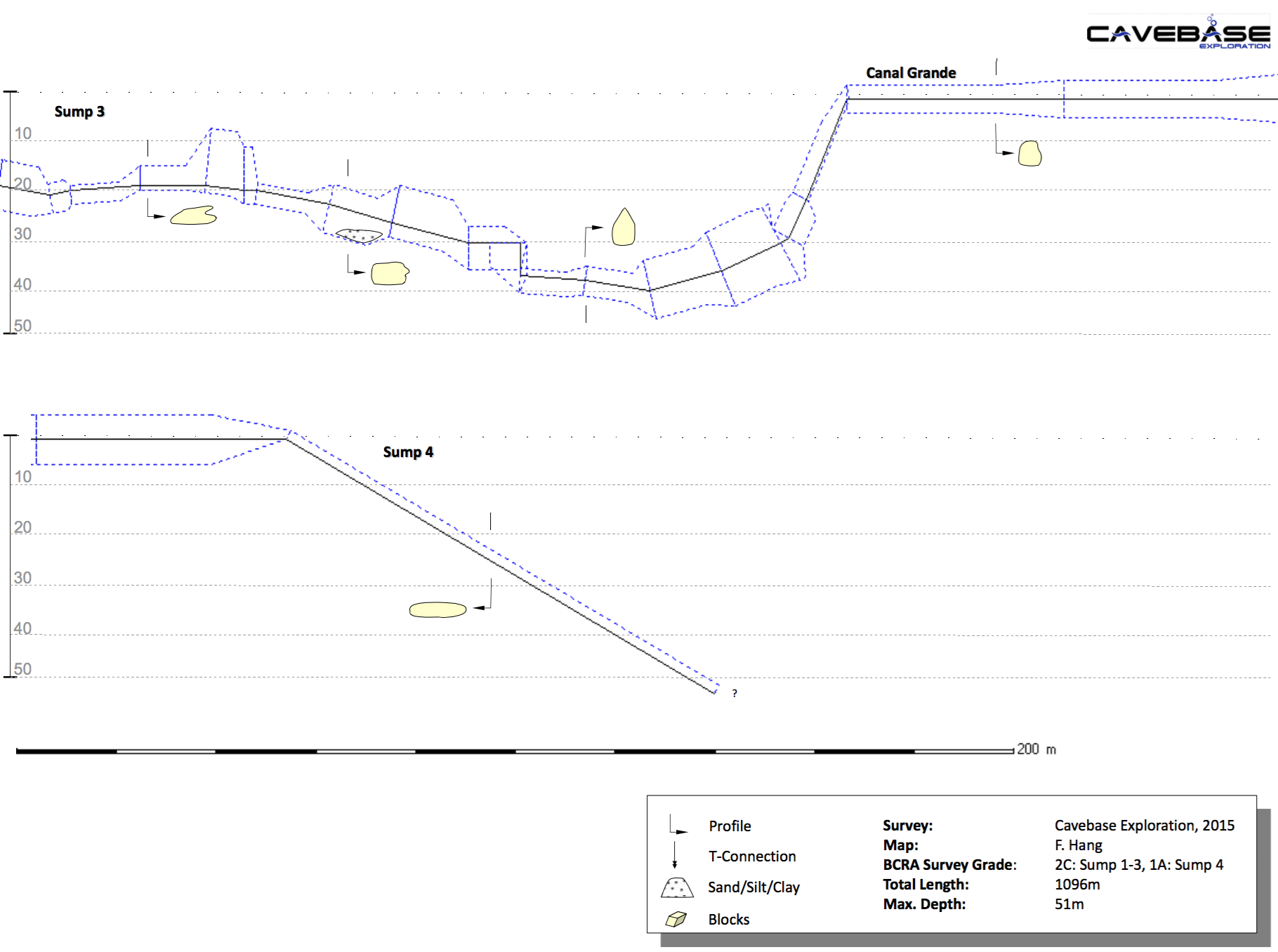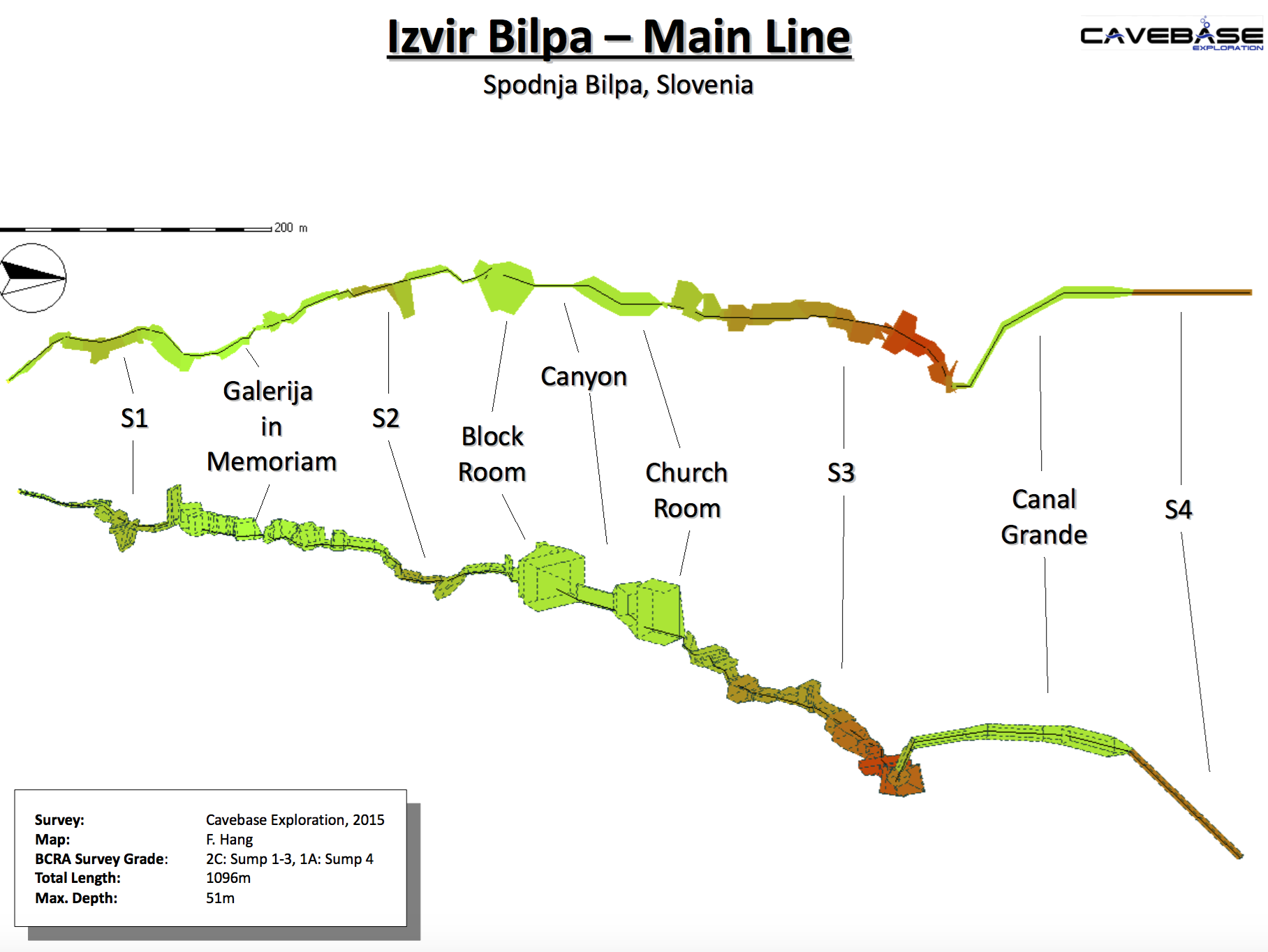
Slovenia 2015
Team: Florian, Wilke, Heinke, Mark, Anke, Tobias, Ben, Ivo
Guests: -
Since we were so fascinated by the karst landscape and of course the caves in the Mediterranean region, we went to Slovenia this time to survey a cave. Florian had made the Bilpa cave the target of our project through a contact to the Slovenian cave divers living there and a scouting tour in winter with Ben. Several karst caves are located on the left bank of the Kolpa River in the valley bordering Croatia and the municipality of Kostel. The Slovenian polyhistor Valvasor described especially the steep rock wall above the caves in the shape of a man's and devil's head and gave it the name "Wall of Echo". The cave consists of cave passages located on different floors; the lowest one is still active. The entrance to the dry cave is located in the wall 30 meters above the valley.
Day 1
Marc and Heinke set off from the north early in the morning after checking that everyone had a snorkel and buoy with them. This was one of the regulations if you wanted to dive caves in Slovenia (nobody knows why, but regulation is regulation). Our "southerners" were still sleeping soundly in their beds. Ivo traveled directly from Prague. In the evening we arrived at our apartment; we were able to store our equipment in a large garage and visit the cave pool, which was located about 300m away on a road and already make the first plans for the next day.

Day 2
Guided by Florian, we set out to explore the cave to see what difficulties we would face in transporting the RBs and other equipment, and how we would have to divide up to accomplish the other tasks. We had an old drawing from 1999, the cave is now well leashed (by Hungarian cave divers who seem to dive the cave regularly), visibility was poor and we discovered side passages not shown in the drawing.
After a short straight stretch from the cave pool, we entered the first siphon to the left. Then you enter a small semi-dry area with water depth up to 1.5m and dive through the 2nd siphon. Both siphons have a max depth of 17m each. The main line ended in a huge dry hall with 2 lakes. There it was time for us to take off gear, grab backup lights and climb. After swimming through the first lake, we had to climb through a very narrow canyon to get to the 2nd lake via a small rocky "river bed". At the end of the lake is a small sandy island. After swimming through another small lake, we get stranded again on a sandbank. After Ivo had unpacked a banana as a little snack in between, it got - creative as we are - the name "Banana Island". It should be the starting point for the RB divers to explore Siphon 3 and how-it-also-goes-on. After about 3h we came out again and started to prepare our equipment for the next day.
The dry tubes still had to be rigged, the helmets fitted with lights; the clothespins for the survey points labeled, the RBs prepared, etc. Wilke headed back; as he had left the bottom plate of the counter lung at home. We got a visit from Igor and Martin, our Slovenian contact, who were able to give us some more tips, as they know many caves here that we wanted to see over the next few days.
Day 3
This day was characterized by lifting, carrying, pushing, cursing, climbing and in between short exhausted rests. Three RBs and many stages had to be brought to "Banana-Island". From the exit into the first lake it went reasonably; the rock is very sharp and wet. The biggest difficulty was getting the RBs through the canyon, which was so narrow in places that you could just squeeze yourself through. But together we made it, so after a short break Tobias, Florian and Marc could get ready. After they had dived down, the others climbed back. A short time later we were called back again. Marc's main lamp failed; therefore he had to go back with the rest of us.
After 7 hours we saw daylight again. We postponed the measuring of siphons 1 and 2 until the next day, but already set the first clamps. Just as we were getting ready to meet the push team, they emerged from the cave pool. They made it through siphon 3, but in siphon 4 we couldn't see how to continue. Siphon 3 ends after approx. 300m and a max. depth of 42m again at the surface in a channel-like passage from which an exit is not possible. First new line had to be laid, which was postponed to the next day, finally one was already a good 10 hours in the cave on the way and exhausted by the dragging.

Day 4
While the push team (this time with Marc) explored siphon 4, Ivo, Wilke and Heinke started to set measuring points and note depth, azimuth and the four distances (pings) to the wall. Anke and Ben were supposed to measure the distances between the measurement points, but since Ben had lost both masks, no other fit him, they headed to Ljubljana to get new ones, so it was up to the first team to do this. Unfortunately, Heinke's drysuit "flooded", so this dive had to be ended early. The push team reached siphon 4 after about 100 meters and maximum depth of 60m. Unfortunately they had to start the way back armed with the wrong gas. They repaired line and laid new line. The total continuous length to this point is a good 1000m.
Day 5
While the push team was on its way to completely survey siphon 3, Ivo, Heinke and Wilke took on the side passages. After about 7 hours both teams emerged happy but very hungry. We were greeted with rain and by the son of the hostel father with the question whether everything was okay and the cave had already reacted to the water. In the hinterland it had probably already rained extensively; he hoped not that the cave starts....
Still in good spirits - because it had already rained on the day of our arrival - we entered the data into the computer.

Day 6
It rained all night, the river in front of the apartment was no longer blue; it was brown. Water shot out of the cave, forming a "mushroom" in the cave pool. The water level rose visibly at about 1.5m. Getting into the cave was out of the question. Three RBs, many stages, two dry tubes and various other equipment, some not secured at all, were in the cave and we did not know what was happening with them.
The rain stopped again at 10:30; the sun was shining, but the water level was still rising. We looked at some "dry caves" in the valley - water was shooting out of them too. In places it was pushing its way to the surface through the asphalt of the road. How is that, when first "everything goes out of joint". At first the whole team seemed to be frozen; again and again a small group went to the cave pool, looked lost into the water, calculated the water level, realized that nothing could be changed and thought about how to continue; already planned to come back in the next weekends...
We decided to stay on the spot. Local experts said that in 2-3 days everything must have calmed down. And we still had time. In the afternoon we got a visit from Igor and Sebastian; they showed us a huge map of a known cave, whose dry area they have already measured up to 4000m. With a few beers we had a nice evening together with them. They also told us about the "Mexico Cave" of Slovenia, so we decided to dive it the next day and take nice photos.
Day 7
Cheerful we made our way to the " Mexico Cave" of Slovenia (Suhadolca). It is said to be max. 15m deep, with good visibility and many stalactites and stalagmites. The way there was very arduous, through the forest and some meters of altitude we had to overcome on foot and a D12 on our backs; then we first went from a river into a long grotto, through which we had to scramble. From there a longer passage, only 1.5m deep, when then the actual cave began - zero visibility! We decided to turn back - then met all in a small semi-dry area and took some more photos to then drag our gear back up the mountain. Wilke headed straight home from there.

Day 8
Plan was either to get the equipment out of the cave, or to raft. But....against a not too strong flow we could dive the cave. The three rebreathers (finally the weight of the things pays off) were still in place (just a little deeper in the water), the stages had spread to the back of the second lake (by the way, this is where the snorkel made sense, we could snorkel in the lake and look for the stages :-) ). One stage was in the front at the resurfacing point. It was probably washed forward by the canyon. The dry tubes (unfortunately open) were also there, including various small parts. Finally we found everything except a stage of Florian, even the mask of Ben and the helmet of Heinke, which was stuck about 2m high in a crevice.
There was mud everywhere, in the canyon the current was so strong that it tore the stages out of our hands and jammed them between the rocks. We had to be careful that the current didn't push us under the rocks; but we were able to get everything out unharmed. In the 1st siphon we lost a dry tube; it could be recovered in the next dive. Anke and Ben were able to record the still missing data. Exhausted but happy we ended the day with a common dinner. The next day we all started our journey home, packed with many new experiences and memories of a really nice project!
PS: The missing stage was found the next weekend by the Slovenian cave rescue team, who conducted a rescue exercise in Bilpa.
With this in mind,
Your Cavebase
Video
Gallery
Kartenmaterial













